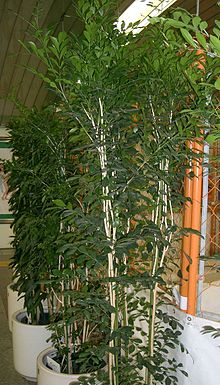- Murraya paniculata
-
- "Orange Jessamine" redirects here. This can also refer to the Orange Cestrum (Cestrum aurantiacum).
Murraya paniculata 
Line drawing of Murraya paniculata, showing flowers and fruit Scientific classification Kingdom: Plantae (unranked): Angiosperms (unranked): Eudicots (unranked): Rosids Order: Sapindales Family: Rutaceae Genus: Murraya Species: M. paniculata Binomial name Murraya paniculata
(L.) JackMurraya paniculata, commonly called orange jasmine, is a tropical, evergreen plant bearing small, white, scented flowers, which is grown as an ornamental tree or hedge. Murraya is closely related to Citrus.
Contents
Synonyms and Common & Local Names
Taxonomical synonyms for M. paniculata are:
- Chalcas exotica (L.) Millsp
- Chalcas paniculata L. (basionym)
- Murraya exotica L.
Some of the common names include
Orange Jessamine, Chinese box, "mock orange", Mock lime, Satinwood [1], or Lakeview Jasmine (mainly in Florida)
- Burmese: ယုဇန [jṵ zana̰] (from Pali yojana)
- Bengali: কামিনী
- Hindi: Kamini (कामिनी)[2]
- Indonesian: Kemuning
- Kannada: Kadu karibevu[2]
- Lao: ແກ້ວ [kɛ̂ːw]
- Malay: Kemuning
- Malayalam: Maramulla [2]
- Manipuri: Kamini kusum [2]
- Marathi: Kunti (कुन्ती)[2]
- Mandarin Chinese: 月橘 (Pinyin: yué jú "moon tangerine")
- Tagalog: Kamuning
- Telugu: Nagagolungu[2]
- Tamil: Kattu Kariyilai or Vengarai (வெங்காரை)[2]
- Thai: แก้ว [kɛ̂ːw]
- Vietnamese: Nguyệt quế.
Description
Orange Jessamine is a small, tropical, evergreen tree or shrub growing up to 7 m tall. The plant flowers throughout the year. Its leaves are glabrous and glossy, occurring in 3-7 oddly pinnate leaflets which are elliptic to cuneate-obovate to rhombic. Flowers are terminal, corymbose, few-flowered, dense and fragrant. Petals are 12–18 mm long, recurved and white (or fading cream). The fruit of Murraya paniculata is fleshy, oblong-ovoid, coloured red to orange,[3] and grows up to 1 inch in length.[4]
Range
M. paniculata is a native of South and Southeast Asia, China and Australasia. It is naturalised in southern USA.[1]
Uses
Traditionally, Murraya paniculata is used both in traditional medicine as an analgesic and for wood (for tool handles).
In the West, Murraya paniculata is cultured as an ornamental tree or hedge because of its hardiness, wide range of soil tolerance (M. paniculata may grow in alkaline, clayey, sandy, acidic and loamy soils), and is suitable for larger hedges. The plant flowers throughout the years and produces small, fragrant flower clusters which attract bees, while the fruits attract small frugivorous birds.[4]
Propagation
The Orange Jessamine is sexually propagated by its seeds. The fruits are eaten by birds, who then pass the seeds out in their stool. It may also be artificially propagated by softwood cuttings.[4]
Diseases
M. paniculata is vulnerable to soil nematodes, scales, sooty mold and whiteflies.[4]
M. paniculata is the preferred host to the insect pest Diaphorina citri, the citrus psyllid. This psyllid is the vector for the citrus greening disease.[5]
Notes and references
Footnotes
- ^ a b http://www.ars-grin.gov/cgi-bin/npgs/html/tax_search.pl?Murraya%20paniculata retrieved on 28 June, 2007
- ^ a b c d e f g http://www.flowersofindia.net/catalog/slides/Kamini.html
- ^ Welsh, 1998; pp 256
- ^ a b c d Gilman, Edward F. Factsheet FPS-416, October 1999; University of Florida Cooperative Extension Service, Institute of Food and Agricultural Sciences; from http://www.coralsprings.org/environment/SmallTreeList/pdf/MURPANA.pdf retrieved on 28 June, 2007
- ^ http://www.hear.org/pier/species/murraya_paniculata.htm retrieved on 28 June, 2007
References
- Welsh, S. L. 1998. Flora Societensis: A summary revision of the flowering plants of the Society Islands E.P.S. Inc., Orem, Utah.
Categories:- Flora of India
- Flora of Queensland
- Murraya
- Sapindales of Australia
Wikimedia Foundation. 2010.



